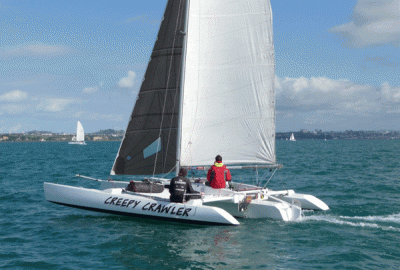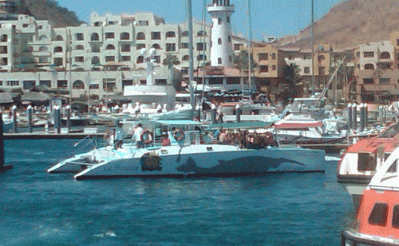I did just get the last of the orders out today from the backlog that built up when I was gone. Its in the mail.
Soft Board Control
I have usually always used blocks bolted to boards to allow the hold-down lines or the lift lines to function. In the same way that spectra wraps now can replace a track and car on the boom, I propose similar for a board. On a smaller board you can use a Harken C 8882. On a slightly bigger board you could use that part cut down the center and attached to both sides of the board. On big boards, I’m experimenting with a faired hole using high strength bog. I will see if teflon coating or graphite coating helps. I assume it will not work quite a well as a block, but be much cleaner.
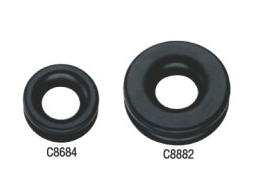
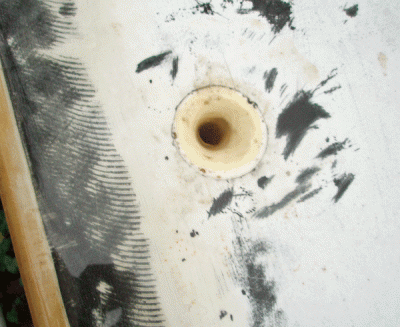
New Pictures of JD’s 30 cat.
Some new pictures of Jim Dory’s 30′ cat have appeared at http://www.flickr.com/photos/jdory/5498545909/in/set-72157625973914417/
This boat was built and launched near Nome, AK. After it was launched, it was tied up in the harbor. During the night, in a gale, that barge broke loose and came to rest against it. There was damage, as you can see. But try to wrap your mind around how little damage actually occured. It was the fender for a barge during a gale.

KHSD Lake Victoria Ferry Launched
Earthwise Ventures launched unit #1 on Lake Victoria recently. The KHSD designed ferry is the first of 10 to be built. They have cylinder molded plywood/epoxy hulls and ply/core/ply epoxy house structure. This boat was built here near Seattle, disassembled and shipped in containers to Africa.
I’m pleased that it sits on its lines OK. They made the top house larger than designed, and were not concerned at all about weight. Unit #2 is underway and will be more elegant. The rest of the units will be built in Africa.
See http://www.youtube.com/watch?v=Y1SwCFtjoFY

Quick Boatsheds
I bought one of these sheds last year for $200. Moto-Shade. 10′ x 20′. http://www.moto-shade.com/Product_Detail.aspx?Id=73
At that website they list stores where you can buy it. The UV breaks the plastic fabric down in less than a year, but tech there told me the trick is to get a new one under the 1 year warranty before the year is up.
Its not big enough for a complete multihull, but many components can be built in one before the multi gets too big.
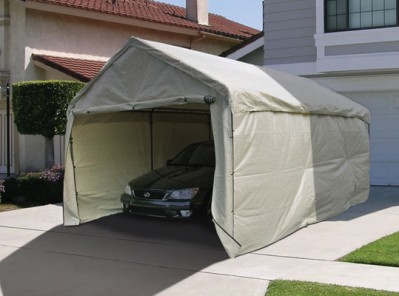
USCG 185 lb. Passenger Rule
I am learning more about the new USCG passenger weight and how it affects your stability letters. The changes are on:
170.170 metacentric height
170.173 righting moment
171.57 intact stability
170.050 passengers heel
Boats with more than 49 passengers will also need their damage stability studies updated.
The added passenger weight does make most single hull vessels less stable.
It does however makes a catamaran more stable. Typically when I submit the stability calculations to MSC, I do the worst case; lightship. Lightship has no passengers included. The extra passenger weight makes the catamaran more stable. MSC understands that but advises that local offices may not.
So I have to run all the spreadsheets for both lightship and fully loaded with 185 lb passengers. And the attendant graphics illustrating what I’m doing. It looks like I can do the lot for 2 hours per vessel. I’m not sure yet how much time revising damage stability will take. I do need a copy of your stability letter and stamped sail plan (unless I already have them. I do have most.)
Due date is December 2011, but don’t wait until its too late.
23′ Trimaran Pictures
Updated CM Print Construction Manual
I did get a chance to do an update to the Cylinder Mold Construction Manual. Its about 99% there, needing just a few more links and a few more graphics. I’m going to figure out how to make it available in both hard copy and PDF. Maybe put it on Amazon.
Cabo Watersports
I took a picture of one of my charter cats in Cabo. Frank Rowden has been running this 46′ day cat for some 15 years. Thats a crowded harbor when the liners come in. http://www.cabosports.com/sailing/index.shtml
Back!
Just back and catching up on everything. I’m making my way through 248 emails, after I weeded out the spam.
